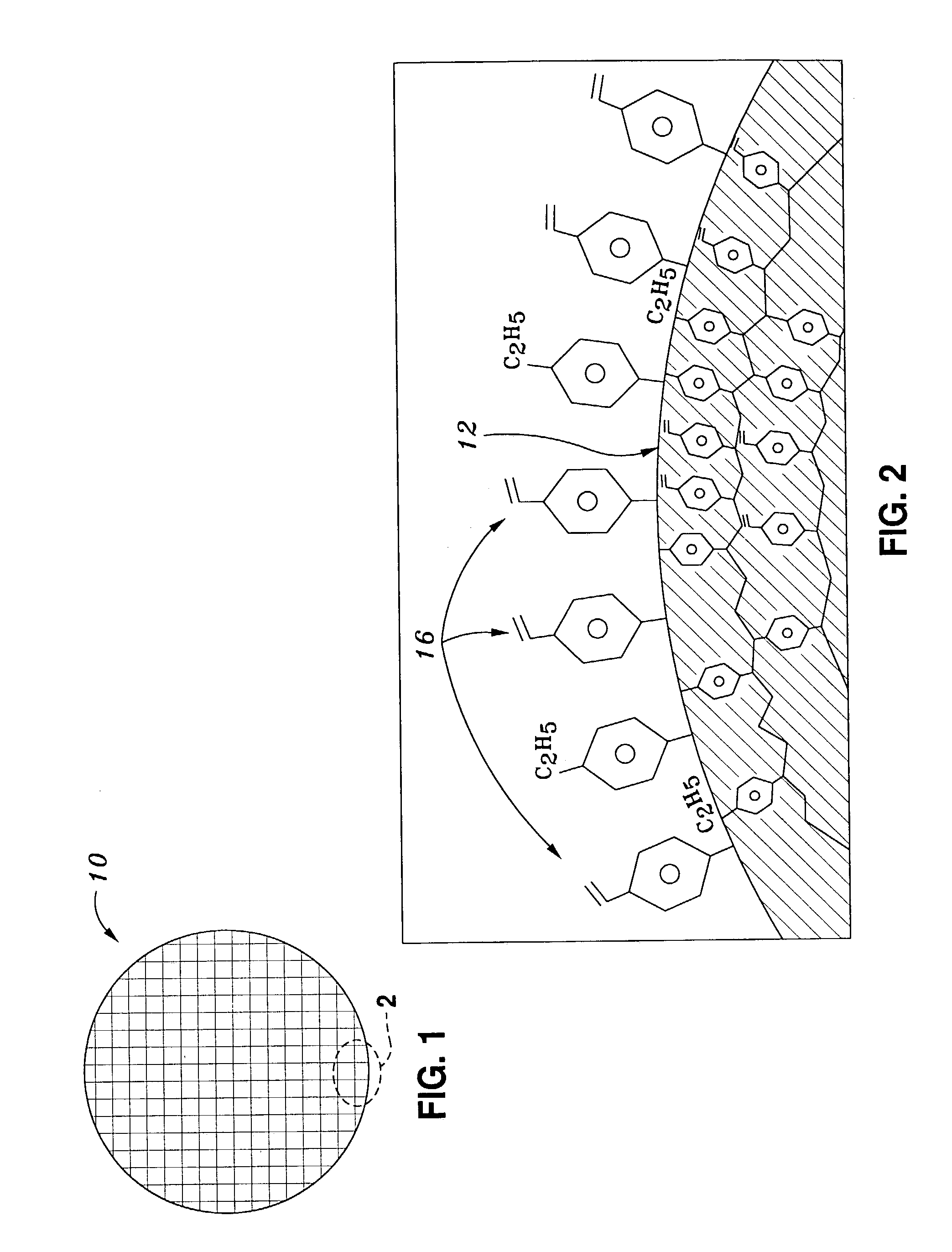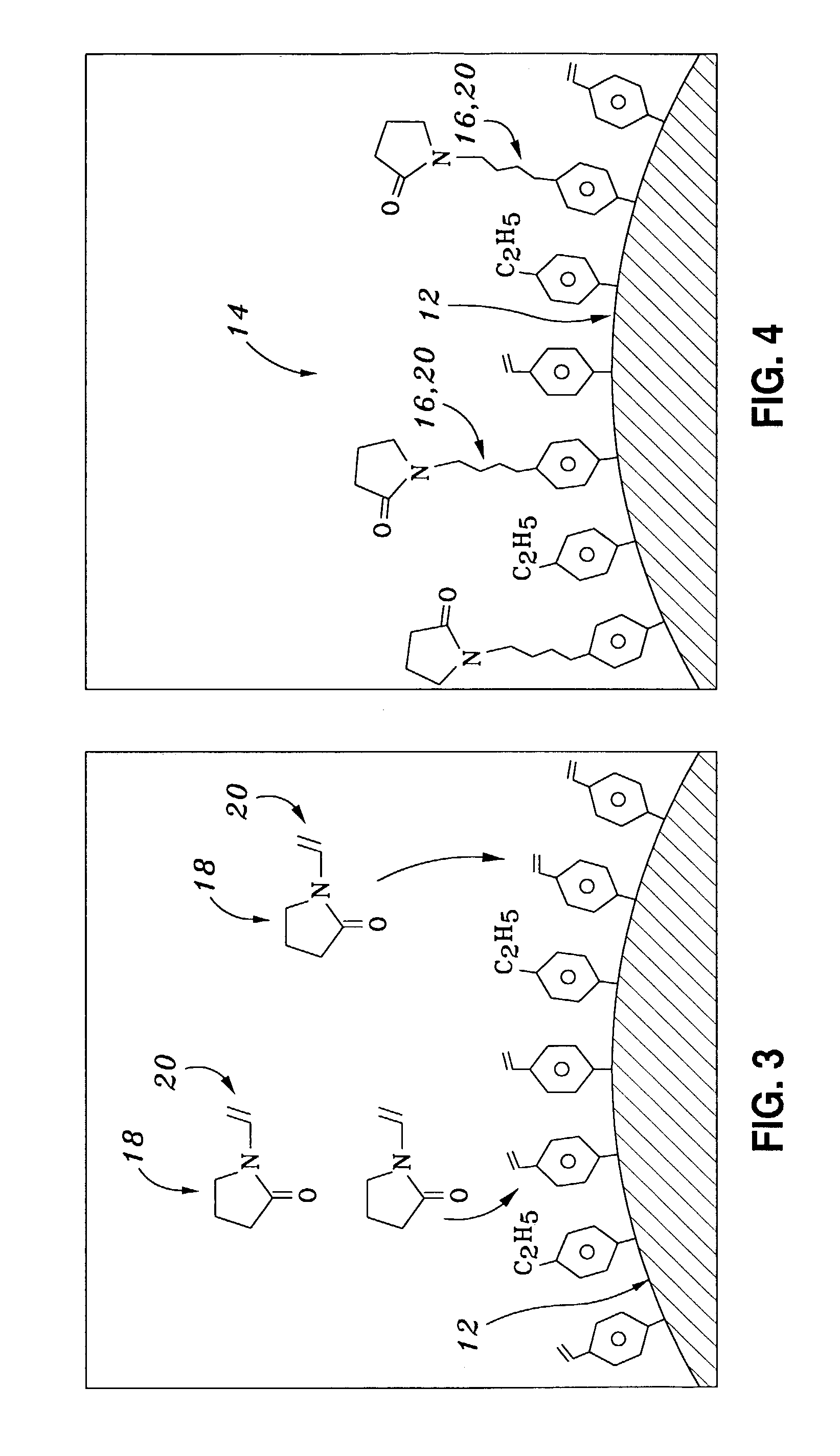Surface graft modified resins and formation thereof
- Summary
- Abstract
- Description
- Claims
- Application Information
AI Technical Summary
Benefits of technology
Problems solved by technology
Method used
Image
Examples
first embodiment
[0037]In a first embodiment, a (poly)styrene-divinylbenze (PSDVB) particle was subjected to free-radical initiated surface graft modification with N-vinylpyrrolidone chemical modifiers. The resulting resin 16 exhibits chemical properties that allow it to be easily “water-wettable.” The chemical properties of this resin allow the surface to maintain its conditioned character even after it has been visibly run dry by vacuum.
Experimentation #2—N-vinylpyrrolidone Surface Graft Modification:
[0038]50 g of a 30 micron, 800 m2 / g surface area and 1 ml / g pore volume PSDVB polymer sorbent made from 80% divinylbenzene and 20% ethylstyrene was added to 300 ml of 1,4-dioxane. To this solution was added 25 ml of the modifying alkene reagent N-vinylpyrrolidone and 0.5 g of the free radical initiator 2,2′-azobisisobutyronitrile (AIBN). This solution was heated to a boiling condition (about 100 C.) for 3 hours, and washed with 1,4-dioxane to remove any un-reacted monomers or polymers formed in soluti...
second embodiment
[0041]In a second embodiment, it is noted that nitrile-modified chromatographic resins are useful for providing alternative chromatographic selectivity to the more commonly used alkyl derivitized phases, such as octadecyl (C18). While nitrile-modified phases are more commonly silica-based, surface graft modification of a polymer particle can be easily accomplished. A nitrile-modified resin 14 can thus be provided.
Experimentation #4—Acrylonitrile Surface Graft Modification:
[0042]50 g of a 70 micron, 500 m2 / g surface area and 1.1 ml / g pore volume PSDVB polymer sorbent made from 50% divinylbenzene and 50% styrene was added to 300 ml of tetrahydrofuran. To this solution was added 25 ml of the modifying alkene reagent acrylonitrile and 0.5 g of the free radical initiator 2,2′-azobisisobutyronitrile. This was heated to a boiling condition (about 66 C.) for 18 hours, and washed with tetrahydrofuran to remove any un-reacted monomers or polymers formed in solution. This modified surface cont...
third embodiment
[0043]In a third embodiment, surface graft modification may also be employed to chemically modify a polymer particle's surface in order to deposit alternate functional groups, such as carboxylic anhydride. The polymer particle can be further reacted with reagents with amine functionality. Amine groups are commonly used for facilitating ion-exchange chromatography.
Experimentation #5—Maleic Anhydride Surface Graft Modification Followed by an Additional Derivitization:
[0044]50 g of a 30 micron, 800 m2 / g surface area and 1 ml / g pore volume polymer particle made from 80% divinylbenzene and 20% ethylstyrene was added to 300 ml of 1,4-dioxane. To this solution was added 25 g of the modifying alkene reagent maleic anhydride and 0.5 g of the free radical initiator 2,2′-azobisisobutyronitrile. This was heated to a boiling condition (about 100 C.) for 3 hours, and washed with 1,4-dioxane to remove any un-reacted monomers or polymers formed in solution. This modified surface contains the reacti...
PUM
| Property | Measurement | Unit |
|---|---|---|
| Fraction | aaaaa | aaaaa |
| Fraction | aaaaa | aaaaa |
| Thickness | aaaaa | aaaaa |
Abstract
Description
Claims
Application Information
 Login to View More
Login to View More - R&D
- Intellectual Property
- Life Sciences
- Materials
- Tech Scout
- Unparalleled Data Quality
- Higher Quality Content
- 60% Fewer Hallucinations
Browse by: Latest US Patents, China's latest patents, Technical Efficacy Thesaurus, Application Domain, Technology Topic, Popular Technical Reports.
© 2025 PatSnap. All rights reserved.Legal|Privacy policy|Modern Slavery Act Transparency Statement|Sitemap|About US| Contact US: help@patsnap.com


